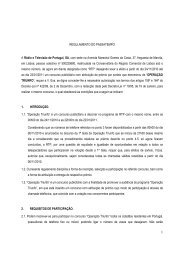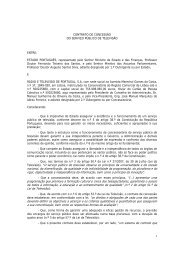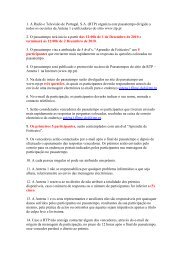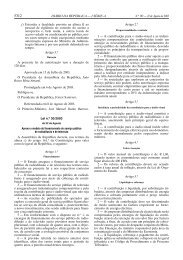In Czechoslovakia, <strong>the</strong> USSR regularly deployed some 105 combat aircraft,located mostly in <strong>the</strong> Bohemian region along <strong>the</strong> German border and in <strong>the</strong> areanorthwest of Prague. There were some 45 MiG-27 Flogger D/Js, 45 Flogger Bsand 14 Su-17 reconnaissance craft. Among <strong>the</strong> some 30 military airfields inCzechoslovakia, Soviet combat aircraft were reported stationed at Prague’sRuzyne airport, Milovice, Cheb/Horni Dvory, Dobrany, Karlovy Vary, Zatec,Mimon, Tchorovice and Panensky Tynec.In Hungary, <strong>the</strong> Soviet Air Force had six major air bases in addition to jointuse of some Hungarian bases and also some dispersal strips. There were about240 combat aircraft deployed, including Su-17 Fitter and Su-24 Fencer attackcraft, MiG-23 interceptors and Su-17 reconnaissance aircraft. Tokol inBudapest, a major Soviet base used jointly with Hungary, deployed fighters,bombers, transports and helicopters and was also <strong>the</strong> headquarters for <strong>the</strong> SovietAir Force in Hungary. O<strong>the</strong>r important bases were at Kaposvar, Papa,Veszprem, Debrecen, Mezokovesd, Pecs and Szomba<strong>the</strong>ly. There was joint useof o<strong>the</strong>r installations at Kalocsa, Szolnok, Kecskemet, Sarmellek and Szeged.In strategically located (relative to <strong>the</strong> main potential <strong>the</strong>ater of operationsalong <strong>the</strong> West German frontier) Poland, <strong>the</strong> USSR earlier based combat aircraftat Legnica, Gniezno, Pucza Bolimowska, Gdansk (naval air Backfires), Zagan,Brzeg, Opole, Szczecin, Kolobrzeg, Szczecinek and Koszalin. The bases atZagan and Szprotawa hosted Su-24 Fencer aircraft.In <strong>the</strong> Far East, again associated with a major ground force deployment, <strong>the</strong>rewere in Mongolia about six squadrons of Soviet combat aircraft, including MiG-21/23/25/27s. They were at Choybalsan nor<strong>the</strong>ast, Ulan Bator southwest,Nalayh, Bayan Suma and two facilities around Sayn Shand which fielded MiG-23s. These were large deployments comparable to those in Eastern Europe,reflecting <strong>the</strong> size of <strong>the</strong> Soviet presence vis-à-vis China <strong>during</strong> <strong>the</strong> period oftension between <strong>the</strong> two communist giants. In addition, some 30 MiG-23s werebased on Eterofu Island in <strong>the</strong> Kuriles (disputed with Japan), along with8000–10,000 troops.During <strong>the</strong> war in Afghanistan <strong>the</strong> Soviet Air Force established a major presencein at least five air bases. These was at Kabul, Kandahar (important forairlift and for naval reconnaissance over <strong>the</strong> Indian Ocean), Bagram (MiG-23base and reported Tu-95 Bear bomber deployment), Shindand (a squadron eachof MiG-21s and MiG-23s, two squadrons of Su-20 fighters and 60 Mi-6 helicopters)and Jalalabad near Pakistan and <strong>the</strong> Khyber Pass, where 100-plusSoviet helicopters were reported stationed. These bases were later used by <strong>the</strong>U.S. after <strong>the</strong> fall of 2001.<strong>Bases</strong> <strong>during</strong> <strong>the</strong> <strong>Cold</strong> <strong>War</strong> 135İ 2007 Robert E. HarkavyOutside of <strong>the</strong> old (Western-imposed) Eurasian containment rim (or “out ofarea” relative to <strong>the</strong> USSR), <strong>the</strong> Soviet Air Force established bases, ad hoc facilitiesand staging rights in virtually all of <strong>the</strong> world’s major regions. Concerning<strong>the</strong> “permanent” or continuous deployment of aircraft (or sporadic deploymentsapproaching that status), this involved most importantly both combat and navalreconnaissance aircraft. The major deployments were, as one might expect, colocatedwith <strong>the</strong> major naval facilities in some of <strong>the</strong> Soviet Union’s closestallies in <strong>the</strong> Third World, such as Vietnam, South Yemen, Cuba, Syria, Libyaand Angola. Still, relative to USAF access overseas, <strong>the</strong> paucity of permanentdeployment of combat aircraft stood out. Perhaps of greater significance was <strong>the</strong>considerable access for Soviet naval reconnaissance aircraft.In Vietnam, alongside <strong>the</strong> major naval deployments at Cam Ranh Bay, <strong>the</strong>Soviet Union deployed some 24 reconnaissance or combat aircraft, 8 Tu-95Bears and 16 Tu-16 Badgers D/K, ten of <strong>the</strong> latter having strike capabilities.71The Badgers’ ranges extended <strong>the</strong> Soviet strike capability over <strong>the</strong> entireSou<strong>the</strong>ast Asian region, notably including <strong>the</strong> U.S. bases in <strong>the</strong> Philippines,but also over Guam and <strong>the</strong> o<strong>the</strong>r U.S. facilities in <strong>the</strong> islands of <strong>the</strong> CentralPacific.72In <strong>the</strong> Southwest Asia/Indian Ocean area, <strong>the</strong> Soviet Union, after 1978, wasprovided access to Yemen’s Aden International Airport and to a military airfieldat Al-Anad, for IL-38/May naval reconnaissance aircraft, <strong>the</strong> Soviet equivalentto <strong>the</strong> U.S. P-3C.73 (These were transited fur<strong>the</strong>r south to Ethiopia and Mozambique.)In <strong>the</strong> Mediterranean, <strong>the</strong>re was similar access for IL-38s in Libya after1981, at Okba ben Nafi, <strong>the</strong> former U.S. Wheelus Air Force Base. Additionally,<strong>the</strong>re were a large number of Soviet Air Force advisers and maintenance person-Page 43
nel in Libya, whose air force comprised MiG-25s, MiG-23s, MiG-21s, Su-22sand Mi-24 Hind helicopters – as well as Tu-22 Blinder bombers and IL-76Candid and AN-26 Curl transports.74Soviet ground force bases75During <strong>the</strong> peak of <strong>the</strong> <strong>Cold</strong> <strong>War</strong>, <strong>the</strong> USSR deployed a massive land army andassociated facilities in Eastern Europe. At <strong>the</strong> peak, that involved some 565,000troops, organized for combat into 30 divisions (16 tank and 14 motorized rifle),plus attached artillery units. The deployments were as follows:1 GDR: 380,000 troops; one Group and five Army headquarters; ten tank andnine motorized rifle divisions; one artillery division; one air assault division;five attack helicopter regiments with some 500 Mi-8 Hip and 420Hind attack helicopters.2 Czechoslovakia: 80,000 troops; one Group and one Army HQ; two tank andthree motorized rifle divisions; one air assault battalion; one artillerybrigade, 2 attack helicopter regiments with 100 Mi-8 Hip and Mi-24 Hindhelicopters.3 Poland: 40,000 troops; one Group and one Army headquarters; two tank136 <strong>Bases</strong> <strong>during</strong> <strong>the</strong> <strong>Cold</strong> <strong>War</strong>İ 2007 Robert E. Harkavydivisions, one attack helicopter regiment with 120 Mi-8 and Mi-24 helicopters.4 Hungary: 65,000 troops; one Group and one Army HQ; two tank and twomotorized rifle-divisions; one air assault brigade with 65 Mi-8 and Mi-24helicopters.76Outside Europe, <strong>the</strong> only permanent major (peacetime) Soviet ground-forcedeployment in an allied country was in Mongolia. There, <strong>the</strong> Red Armydeployed two tank and three motorized rifle divisions, 65,000 troops in all(earlier <strong>the</strong>re were 75,000) vis-à-vis China.77 These forces filled a gap in <strong>the</strong>Sino-Soviet confrontation line amid a much larger overall Soviet deployment in<strong>the</strong> Far Eastern <strong>the</strong>atre of some 53 regular divisions (seven tank, 45 motorizedrifle, one airborne), abetted by four artillery divisions and two air assaultbrigades.The Soviet Union’s o<strong>the</strong>r main external ground force was, of course, <strong>the</strong>large army of some 118,000 troops engaged in combat in Afghanistan, whichincluded 10,000 Ministry of Internal Affairs (MVD) and Committee of StateSecurity (KGB) troops. That force remained, numerically speaking, at a fairlyconstant level from <strong>the</strong> initiation of hostilities in 1979, to its conclusion in 1989.There are several o<strong>the</strong>r locales where clusters of Soviet-bloc advisers andmilitary technicians were significant beyond <strong>the</strong> “norm” for standard militarymissions. These were in Algeria (1000), Cuba (8000), Ethiopia (1500), Libya(2000), North Yemen (500), South Yemen, (2500), Syria (4000) and Vietnam(2500), with small numbers in India, Iraq, Cambodia, Laos, Mali, Mozambique,Nicaragua and Peru. Each was a major recipient of Soviet arms. The muchargued“Cuban brigade” – whe<strong>the</strong>r defined as a combat formation or as a collectionof support troops – achieved some notoriety in 1979 when publicity over itspresence (and arguments about whe<strong>the</strong>r it represented a violation of agreementsmade at <strong>the</strong> close of <strong>the</strong> 1962 Cuban Missile crisis) was important to <strong>the</strong> abortingof <strong>the</strong> SALT II Treaty by opposition in <strong>the</strong> U.S. Senate. Soviet forces in Syriawere important in <strong>the</strong> wake of <strong>the</strong> latter’s debacle in <strong>the</strong> 1982 war with Israel –<strong>the</strong>y manned <strong>the</strong> some 48 long-range SA-5s which could have contested Israeliair control even over <strong>the</strong> Mediterranean in <strong>the</strong> event of renewed hostilities.Earlier, prior to 1972, <strong>the</strong>re was a large force of Soviet troops – some 20,000 –deployed in Egypt’s Suez Canal area, mostly to man air defense installations. In1977–1978, some Soviet forces aided Ethiopia in its war against Somalia.Soviet technical facilities abroad78During <strong>the</strong> <strong>Cold</strong> <strong>War</strong>, <strong>the</strong> USSR made – relative to <strong>the</strong> U.S. – much less use offoreign facilities for technical functions – communications, space-related, antisubmarinewarfare, nuclear detection etc. This was variously due to muchgreater utilization of shipboard facilities; <strong>the</strong> larger (relative to <strong>the</strong> U.S.) Sovietland mass in relation to <strong>the</strong> major focus of <strong>the</strong> superpower competition along <strong>the</strong>Eurasian rim, which allowed many functions to be performed within <strong>the</strong> USSR;<strong>Bases</strong> <strong>during</strong> <strong>the</strong> <strong>Cold</strong> <strong>War</strong> 137İ 2007 Robert E. HarkavyPage 44
- Page 2 and 3: This provided the U.S. access to a
- Page 4 and 5: ecame a hot issue within Japan, and
- Page 6 and 7: SpainRotaMajor naval base; also air
- Page 8 and 9: eturn to the link here with aircraf
- Page 10 and 11: which were in Fairbanks (Alaska), T
- Page 13: Molesworth), Belgium (Florennes), t
- Page 17 and 18: III,” 14 stations giving flexible
- Page 19 and 20: wire retaliation strike plan. The n
- Page 21 and 22: Ocean surface surveillance47The U.S
- Page 23 and 24: each site, providing variable cover
- Page 25 and 26: Pinetree LineCanadaBroughton Island
- Page 27 and 28: that is, the Limited Test Ban Treat
- Page 29 and 30: Missile Crisis.68At another level,
- Page 31: Access for Soviet surface ships.Per
- Page 35 and 36: systems (an exception, of course wa
- Page 37 and 38: Madagascar). There was also a signi
- Page 39 and 40: Aden, Bahrain, Malta, Mauritius, Si
















